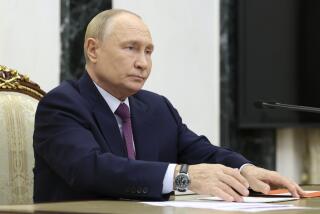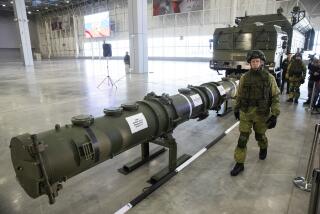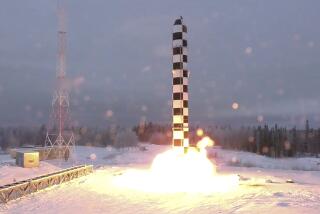Soviets Ease Demands on SDI, Nitze Reports
WASHINGTON — In a “more precise statement than ever before,” the Soviet Union has further eased its demands for limiting work on the Strategic Defense Initiative, chief U.S. arms control adviser Paul H. Nitze said Monday.
In its new position, Moscow continues to back away slowly from its most extreme stand against SDI, the space-based missile defense system known as “Star Wars.” Originally demanding a ban on SDI research, the Soviets later proposed keeping research within walled laboratories. Now they would allow limited SDI research in space.
The series of Soviet shifts have led some U.S. analysts to speculate that Moscow might be preparing to drop its longstanding demand for a direct link between cuts in offensive nuclear weapons and curbs on anti-missile defenses.
Instead, the Soviets would only demand that any strategic offensive arms agreement contain a clause canceling the pact if there is any violation of the 1972 Anti-Ballistic Missile Treaty.
“They go in for both belts and suspenders,” as one senior official joked about the Soviet approach. “But it may be that they are positioning themselves to give up one of those supports.”
The general Soviet softening on the issue had been reported after the recent visit here by Soviet Foreign Minister Eduard A. Shevardnadze. But Nitze provided the first public details of the shift. Although the latest change appears to promise progress toward an agreement, it must be explored in detail at the arms control talks in Geneva.
Nitze, speaking at an arms control meeting of the American Assn. for the Advancement of Science, said in response to questions that Shevardnadze has offered alternative ways to impose such curbs within the framework of an agreement on missile defenses.
Two Possible Courses
Both would begin with a 10-year period during which deployment of missile defenses in space would be barred, as now provided by the ABM treaty.
After 10 years, one of two courses would be open:
-- The two sides would agree on a list of devices based on exotic technologies, such as laser beams, that could be tested in space, and on limits on the power and size of such tests, including the “brightness” of the laser and the diameter of its reflecting mirror.
-- Or both sides would reaffirm the ABM treaty “as negotiated and ratified,” Nitze said.
The only difference from the Soviets’ previous position is that they now offer a list of exotic devices that could be tested in space below some thresholds. They had argued previously that no tests in space of such devices were permitted under the ABM treaty.
Limited as the change is, it has sparked speculation among U.S. officials at various levels that the Soviets could be positioning themselves for possibly dropping their insistence on a separate anti-missile accord as part of the arms control package.
Under such a scenario, in which the Soviets would rely on a cancellation clause in the offensive weapons agreement, Moscow would be counting on the U.S. Congress to ensure that all SDI work complied with the narrow interpretation of the ABM treaty.
This train of events, which is considered unlikely but not impossible, might even find the White House suddenly backing off its position that SDI and strategic arms reduction cannot be linked.
Instead, officials suggested, the Administration might be willing to accept some negotiated restraints on its SDI program for fear that a hostile, Democratic-controlled Congress--already antipathetic to the SDI program and strongly favoring deep cuts in offensive arsenals--will lean over backward to impose greater restraints than the Administration could negotiate with the Soviets.
The Administration and Congress differ significantly on what work is permitted under the ABM treaty. The Administration insists that the agreement does not restrain research, testing or development of missile defenses based on “other physical principles,” such as exotic beams. Congress, seeking to restrain SDI, maintains that only research is allowed on devices, whether based on conventional or advanced technology.
Nitze is at odds with the White House in favoring discussions with the Soviets to clear up some vague parts of the ABM treaty, which he helped to negotiate.
When the ABM pact was negotiated, he said, “other physical principles” could not be defined well.
The United States proposed to incorporate restraints on exotic weapons, he said, “but the Soviets said they were not about to commit themselves to restrictions dealing with ‘other physical principles.’ They rejected our language.”
Now the Soviets maintain that SDI work on exotic devices is barred by the treaty. Nitze rejects that argument but acknowledged Monday that “there is a great deal of uncovered ground” in the agreement that could be profitably discussed with the Soviets.
The Administration, however, fears that such discussions can only lead to restrictions on SDI activities.
More to Read
Sign up for Essential California
The most important California stories and recommendations in your inbox every morning.
You may occasionally receive promotional content from the Los Angeles Times.










